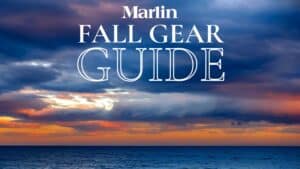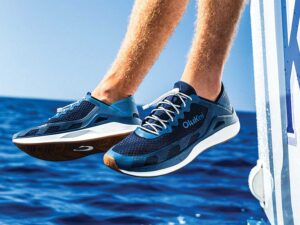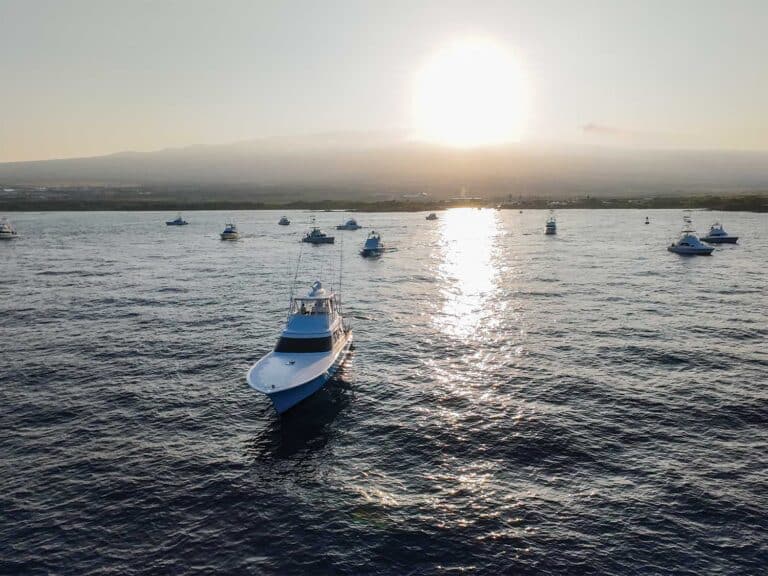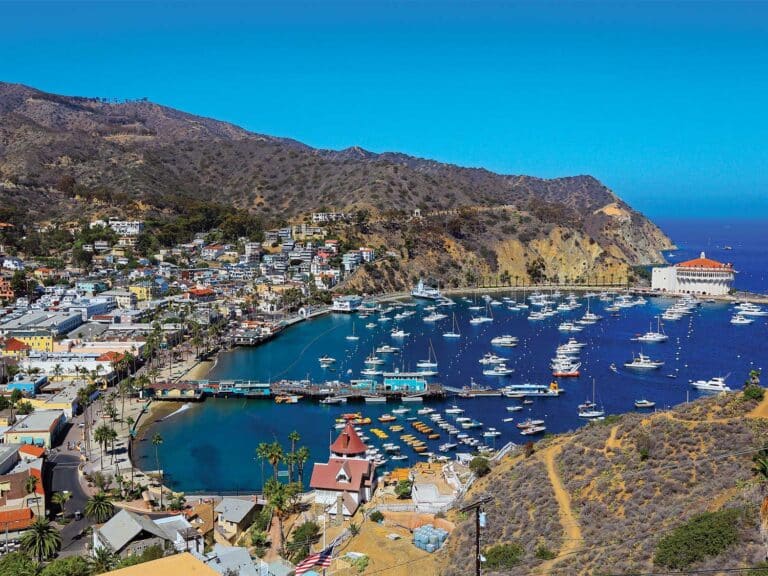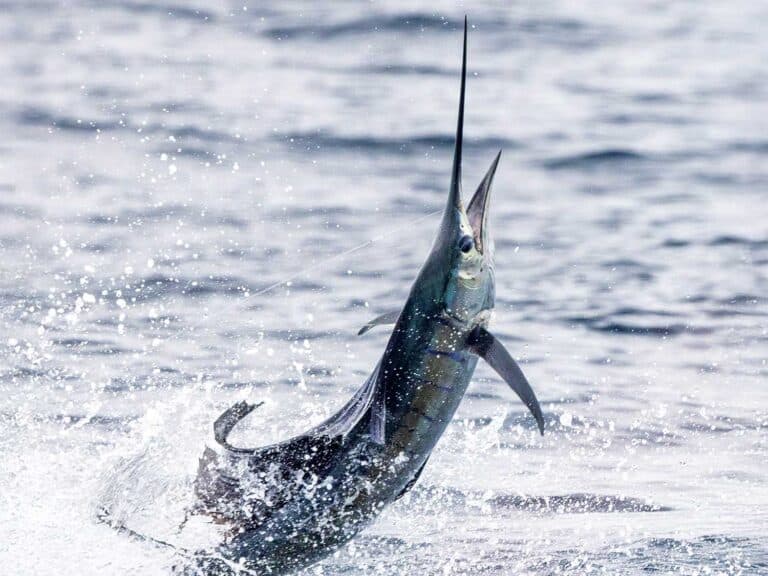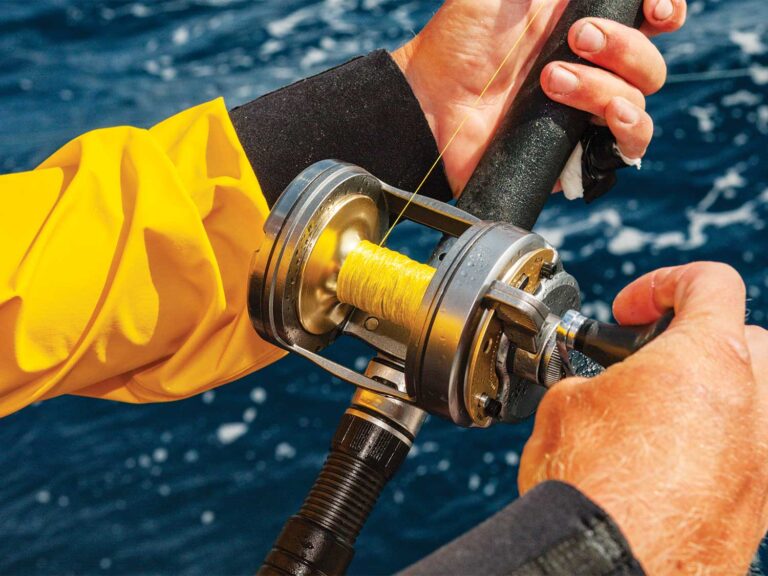See 1-25 of the Marlin 100 here / See 26-50 of the Marlin 100 here / See 76-100 of the Marlin 100 here
51. Rubber Bands
One of the most versatile and common tools found on any sport-fishing boat has to be the rubber band. Mates use them to cushion the main line from outrigger or flat-line clips, rig baits, secure all kinds of items, keep the bread fresh or raise a welt on a grouchy captain’s calf. Whatever you do, don’t leave home without them.
52. Mold Craft Wide Range
One of the original Mold Craft lures, the Wide Range came to Frank Johnson through the suggestions of Capt. Peter Wright in 1977. Wright and Capt. Jeff Fay were experimenting with lures made out of rolls of sheet rubber while working together on Humdinger in Hawaii during the mid-1970s. Wright showed his prototypes to Johnson during a charter, and they struck a deal on the spot to make the lures.
The lure gets its name from the “wide range” of speeds and conditions you can troll it in without affecting its performance. With its squared-off nose, elongated head and center hole, the Wide Range stays stable in almost any conditions.
On almost every boat I board, no matter where I am in the world, I’ll usually find a Mold Craft Wide Range. If I could pick only one marlin lure to fish with anywhere, it would be a purple/black Mold Craft Senior Wide Range rigged with a single hook placed as far back in the skirt as IGFA rules allow. It runs straight and true no matter how rough it gets or how fast I go, which makes it the perfect lure for a guy who doesn’t know what he’s doing. – Dave Ferrell
53. Slams
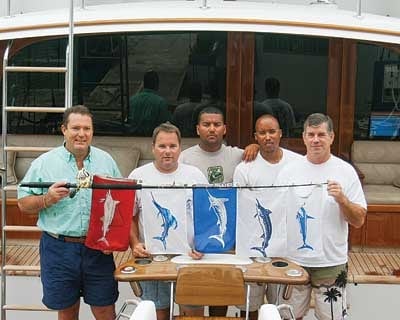
Any day you catch any species of billfish is a good day on the water. Add another species and you start entering the realm of the “banner day.” Add a third species and you’ve reached the promised land of billfishing, the grand slam. But slamming out doesn’t have to stop there; you can catch four species for a super grand slam or five for the fantasy slam.
Obviously, the best places to pursue a slam are destinations that harbor good numbers of more than one billfish species at the same time of year. Venezuela probably represents the best place to try for a slam in the Atlantic, with October and November being the peak months to catch a blue, a white and a sail. You can also catch spearfish and swords in Venezuela, so it’s also the top spot to try for a super or fantasy slam. In fact, the only two fantasy slams we know about came from Venezuelan waters.
With plenty of sails, blues, stripes and blacks, the Pacific coast of Costa Rica comes in a close second in the slam race. Fishing out of Guanamar from December through February puts you in the best possible time and place for a Costa Rican slam.
54. Multiple Hookups
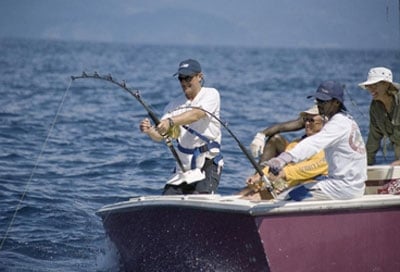
Watching two of anything jumping behind the boat gets everyone’s adrenaline pumping – especially when the fish end up taking off in different directions. Longtime captains relish the challenge, however, and watching a good boat handler round up two, three or even four fish at one time thrills everyone to the bone.
With anglers crisscrossing back and forth across the transom and the “go overs” and “go unders” ringing in the air to avoid tangles, multiple hookups really teach novices the importance of moving their feet to follow the fish and give experienced anglers the chance to shine.
Since more captains have started turning on the initial bite and continuing to troll as they circle the first hooked fish, multiple hookups come a lot more frequently. This makes sense since no one has ever caught a doubleheader by reeling all their gear in at the first sign of a hookup. If you always assume there is more than one back there, you’ll catch a lot more doubleheaders.
55. The “A” Dock in St.Thomas

Few places on earth ooze the raw essence of sport fishing like the A-Dock at American Yacht Harbor, Red Hook, St. Thomas, USVI. Every summer, from June through September, during the weeks just before and after the full moons, boats come from all over North America and the Caribbean to get a shot at the most consistent blue marlin bite on the planet. A-Dock hosts several of our sport’s premier marlin boats, including Sam and Jon Jenning’s Revenge, Free Enterprise with Capt. Randy Gendersee and the local charter boat Marlin Prince with Capt. Eddie Morrison.
Long before the season starts, visiting boats jockey to get a slip on this prestigious, testosterone-fueled section of dock, but space is limited and only those who make arrangements years in advance get a spot. There’s no argument that some of the world’s best blue marlin crews set up shop here; anyone can learn a thing or two about caring for a big sport-fisher and preparing for a day’s fishing by simply taking a stroll down A-Dock during any summer morning before the boats leave for the North Drop. On the last full moon in August, A-Dock erupts in a giant end-of-the-season party where you can mingle and bend your elbow with some of the sport’s best captains, mates and anglers – it doesn’t get any better than that.
56. Blue-and-White Ilander
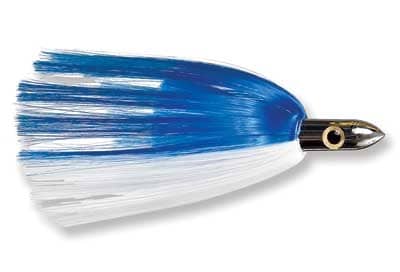
The legendary Ilander, or “Hawaiian Eye” as some of you still know it, has probably caught twice as many blue marlin on the Atlantic Coast as its nearest competitor. The Ilander is another one of those lures you’re apt to find on board in even the most remote fishing holes on earth.
Developed by Jim Kress in 1976, the lure was initially named the Hawaiian Eye and was designed to troll at high speeds on the way out to the fishing grounds. The Ilander accounted for several innovations found on many lures today: It was the first true high-speed trolling lure, the first to feature permanent nylon skirts and the first to use realistic eyes.
Versatility (along with tremendous productivity) probably accounts for most of the Ilander’s success. When teamed up with a naked horse ballyhoo, the blue/white Ilander represents the bait of choice for marlin skippers on the East Coast.
The lure is so popular that its use played a large part in a retraction of the National Marine Fisheries Service’s call in 2007 for the mandatory use of circle hooks in billfish tournaments when using live or dead bait. A huge number of dead-bait trollers didn’t want to put circle hooks in front of their beloved Ilanders. (The law has since come back into effect for 2008, and several captains report good results running a circle hook out in front of their ballyhoo-Ilander combos.)
57. The Bait-and-Switch
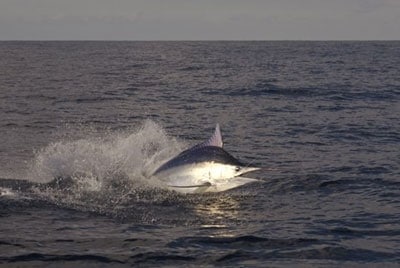
Initially developed by world-record fishermen to help present the proper line class to a raised fish, the bait-and-switch quickly jumped into the mainstream once anglers found out how much fun it is to present a bait to a billfish and watch it eat the bait a mere 10 feet off your rod tip! More than just a winch sitting in a chair, bait-and-switch anglers get into the game, dropping back and hooking the fish before doing stand-up battle or heading to the fighting chair.
But the angler’s pleasure is really just secondary on this one. Whoever’s on the teaser reel, either the captain working a bridge teaser or the mate on a cockpit rod, gets all the fun by teasing an enraged billfish right up to the transom. And the spot to watch it all happen isn’t in the fighting chair; sitting up on the flybridge affords the best view. Once you stay upstairs and watch it all unfold a couple of times, it’s hard not to bounce up the ladder every time the captain says he has one jerking on the teaser.
To be proficient at the bait-and-switch, you must learn how to use and be comfortable with a lever-drag reel. And although the mechanics of dropping back a bait are incredibly simple, it’s the mental aspect that usually trips up most people. For some reason an angler’s hands can suddenly stop working properly when there’s a 400-pound blue thrashing the teaser 10 feet off the left corner. We just can’t imagine why that is so.
58. First-Catch Plunge

The sport of big-game fishing comes with a wide array of traditions and superstitions that supposedly influence what you’re going to catch. But the one that brings a smile to everyone’s face is the first-catch dunking. Sport-fishing tradition holds that any angler catching his or her first billfish species, be it a white, blue, sail or whatever, gets tossed into the drink upon return to the dock. And remember, if you fight the swim, things can get ugly fast. Just make sure you ditch your cell phone before taking the plunge.
59. Kona, Hawaii
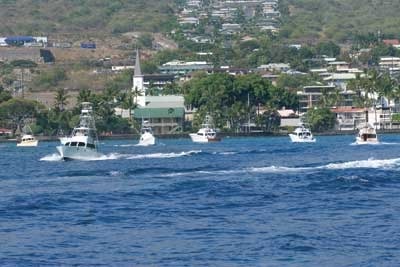
Sport-fishing legends Henry Chee and George Parker were among the first to solidify Kona, Hawaii’s, position on the short list of the best places on the planet to land a big blue marlin. Tournament organizer Peter Fithian took it a step further and showcased the quiet village of Kona to a worldwide audience when he began the Hawaiian International Billfish Tournament, which celebrates its 49th year in 2008. You’ll often hear the HIBT referred to as the “grandfather of all big-game fishing tournaments” because it created many of the rules used in today’s tourneys.
The formula is working – more charter boats and tournaments are in Kona than ever before – you’ll find the fleet fishing an event just about every weekend during the summer. Clients come to the Big Island from all over because they know there’s a chance they might just find a grander in these calm waters. With that in mind, you better plan a pit stop in Kona if your ultimate goal is to catch a 1,000-pound blue marlin.
For info on the HIBT, visit www.hibtfishing.com; for info on the Maui Jim tournament series, visit www.konatournaments.com; and to book a charter out of Honokohau Harbor, visit www.charterdesk.com.
60. Sampo Swivel

It’s amazing how much difference one little piece of equipment can make. I recently returned from a trip where I fished with one of the top captains and mates in the world and was shocked to see them using plain barrel swivels on the end of their wind-on leaders. Unfortunately, barrel swivels do not spin under any kind of load – even the weight of a skipping ballyhoo. The resulting twist imparted to the line by the ballyhoo forced the mates to pull one of the rods and reels out of the rotation every 20 minutes so they could take the bait off and let the line fall back into the prop wash to let it unwind. Although a bit more expensive, a simple Sampo ball-bearing swivel would have saved them a lot of time and trouble. – Dave Ferrell
61. Black Marlin
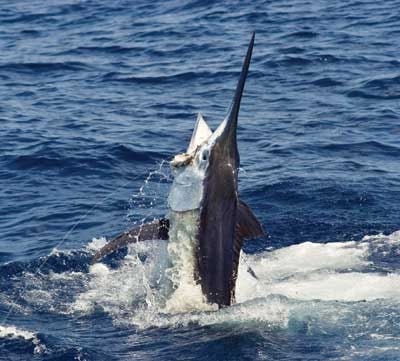
I’ve caught a lot of billfish in my time, but black marlin dish out the toughest fights I’ve ever experienced on rod and reel. I love catching big blue marlin and giant bluefin tuna, but nothing is as tough as a big black that hasn’t been mortally wounded by the hook.
Having said that, the average marlin, blue or black, is usually much easier to catch than a tuna of the same size, simply because marlin jump. A jumping fish burns up energy, and since the fish is up on the surface, a skilled boat handler can close the gap and make the angler’s job a lot easier. We often chase down even the largest of marlin for a quick tag-and-release.
However, if more than a few yards of line are out when a big black quits jumping, her sheer size and body shape, including the rigid pectoral fins that are their signature feature, allow her to dive down and stay there. They stay down and use the time to recover from the oxygen debt generated by the fast runs and leaps at the start of the battle. I use the heaviest rods and more drag on black marlin than I do on any other fish, and it still takes longer to pull them to the boat. Black marlin are just plain bad! – Peter Wright
62. Ballyhoo
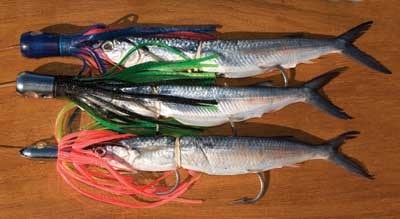
For a fish that doesn’t spend any time offshore during its natural life, the poor ballyhoo makes a seemingly unusual choice for a blue-water bait. Yet blue marlin, sails, dorado and generally all of the fish that swim in deep water love to pile on a properly rigged ballyhoo.
Several special qualities seal the fate of this petite species, making them perfect trolling baits. Their small size allows them to go down the hatch easily on the bite and also makes them great candidates to troll in combination with a lure head or skirt. Ballyhoo also exhibit a certain amount of toughness when properly brined and cared for, allowing them to hold up to several miles of trolling. And finally, their long, slender shape enables crews to rig dead ballyhoo that seem to swim better than live ones.
The ubiquitous pin rig introduced several generations of East Coast
offshore anglers to their first ballyhoo, and crews still pull this wire-leader rig for everything from kingfish to sails.
63. Real Wire and Pure Adrenaline
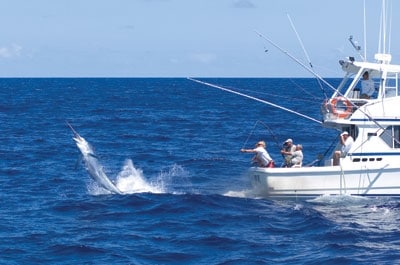
Standing in a cockpit wearing reinforced gloves and watching the double-line vibrating madly through the water, an expert mate stands focused on the thin, taught rod of steel that was a relatively supple piece of wire before a heavy fish latched onto the other end of it. As the boat spins and twirls, engines switching constantly from forward to reverse, several scenarios race through the mate’s mind, not all of them good ones. “What the hell’s going to happen when I start to pull on this leader?”
Using pure monofilament or wind-on leaders may be the most efficient ways to catch fish, but the best wiremen do not like using either one of them. Because of the stretch inherent in monofilament, a good mate gets better control of the fish using tinned or galvanized wire.
A great wireman only does his best work with the help of a great angler and skipper. If the angler can’t pull over 70 pounds of drag or the skipper can’t help the mate gain inches when the line is straight down just off the covering board, it makes wiring (or leadering) a lesser feat. Truly good wiremen are a rare breed and are becoming harder and harder to find. – Peter Wright
64. White Marlin Open

Ocean City, Maryland, calls itself the “White Marlin Capital of the World,” and the White Marlin Open helped it gain that status. Held each August, this tournament typically attracts more than 400 competing boats hoping to grab a piece of the big money available. The 2007 winning team on Rebel, out of Nag’s Head, North Carolina, won nearly $1.4 million for catching an 83-pound whitey; that’s more than $16,800 a pound! Not bad for a day’s fishing. Visit www.whitemarlinopen.com for more info.
65. Tagging
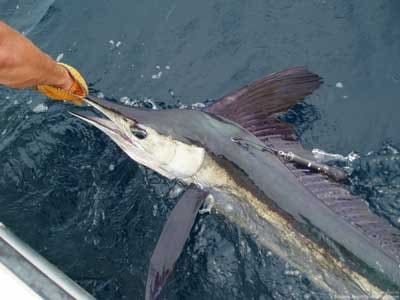
The best way an angler or captain can help conserve billfish is to take part in a tag-and-release program. That little piece of plastic placed on a billfish’s back can provide scientists with valuable information on marlin migration and age/growth rates.
“The biggest value of tagging studies is creating a long-term data set,” says Derke Snodgrass, a National Marine Fisheries Service fishery biologist who works with the Cooperative Tagging Center. “We’ve now got a 50-year data set, which allows us to look at trends in the fishery. It helps us estimate survival rates for released fish and outline migration patterns. But to me, the best part of tagging is getting fishermen involved. I think that a captain who tags feels more connected to the fish they are fishing for.”
The Billfish Foundation represents the largest tagging agency in the world. Ellen Peel, president of TBF, estimates that more than 150,000 TBF tags have been deployed around the world, but that isn’t enough. Less than 1 percent of tags placed in fish are recovered. However, these recovered tags help unlock the mysteries of billfish migration.
In recent years pop-up satellite archival tags have helped scientists learn even more about billfish behavior. These tags record depth changes, movements and other information before they pop off the fish and send the information back to the scientist via satellite. But these tags are very expensive, and researchers are continually trying to get grants and patrons to help cover the costs. The payoff, however, is well worth it. Fishery managers use the data collected to help protect billfish, especially when and where they spawn. We need this information to rebuild billfish populations. Get involved by joining TBF at www.billfish.org.
66. Flying Flags

While the etiquette varies from place to place, motoring into port with a rigger full of release flags flying sure makes everyone on board walk with their heads a little higher. A quick glance down the dock tells everyone if the fish are biting and who’s catching what – you don’t even have to say a word.
67. Club Nautico de San Juan International Billfish Tournament

What marlin tournament in the world do you know of where you can show up all by yourself with rod and reel in hand and a check for $1,750 and fish for four days against some of the best blue marlin fishermen in the world? There’s only one and that’s the Club Nautico de San Juan International Billfish Tournament. The longest continually run marlin tournament in the world, the San Juan Int’l celebrates its 55th anniversary this month. The tournament also holds the record for the most blue marlin caught during a four-day tournament, with 190 set in 1988.
The San Juan represents a truly international event, with the International Team prize the most coveted award given during this first-class tournament. A spectacular opening ceremony, nightly parties, great food and loads of people from all over the world sharing the same passion make the San Juan International a must-fish event on any billfish angler’s dream list. To find out how you can be there later this month, visit www.sanjuaninternational.com.
68. Beers of the World

When it’s time for “a lucky cold one,” there’s nothing like reaching into the cooler and pulling out a frosty can or bottle of the local brew. Whether it’s the tiny, delicious Polars in Venezuela that seem to go down two at a time, the tall golden Kaliks in the Bahamas or the biting crispness of Costa Rica’s Imperial, all beer tastes good after a great day on the water. Shotgun!
69. Bimini Twist
**

**
Crews rely on a variety of knots to tie on hooks, rig baits, connect one line to another or simply add a chafe loop to the main line with rigging floss. But if you step on board without the ability to tie a perfect Bimini twist, you’ll be sent packing before your gear hits the bunk. If there’s one knot that defines our sport more than any other, it’s the Bimini twist.
Used for years by big-game crews to create a double-line up to 10 feet long, a properly tied Bimini twist holds 100 percent of the breaking strain of the line, and some say the coiled wraps add additional stretch to keep a sudden impact from snapping the line. Today, with the advent of wind-on leaders, a lot of crews still tie Biminis but with a much smaller loop that they use to attach the wind-on section of the leader with a loop-to-loop connection. Learn it or face the ridicule of your peers.
70. Tropic Star Lodge
Nestled into the back corner of Piñas Bay, Panama, Tropic Star Lodge enjoys one of the most idyllic locations on the planet. Miles away from any roads and surrounded by the Darien Rainforest, Tropic Star defines the words “quiet seclusion” ? until 5 a.m., that is, when the crew comes to your door with the morning’s coffee and wake-up call. And you’ll want to get up and get a move on – the famed Zane Grey Reef lies just a few minutes offshore, and your personal 31 Bertram sits ready and waiting at the dock. Although anytime is a good time to visit Tropic Star Lodge, the winter and spring from December through April probably represent the peak. Don’t be shy to visit during the summer if they are booked up for the spring. The boats have been venturing farther offshore and have discovered a great blue and striped marlin fishery in August and September. The bottom line: Tropic Star Lodge most likely stands out as the best big-game fishing lodge in the world. For more info, visit www.tropicstar.com.
71. Big Dolphin
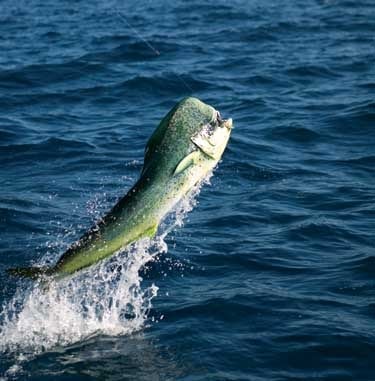
Some folks consider the dolphin to be the perfect game fish and with good reason. One of the most strikingly gorgeous fish that swims in the sea, dolphin grow to a respectable size, leap like mad dogs when hooked and provide some of the best eating on the dock. They sometimes appear in huge concentrations and grow and reproduce at prodigious rates, putting on more than 10 pounds a year. As a matter of fact, most dolphin encountered by sport fishermen are less than 2 years old. A 5-year-old fish is ancient and should weigh in the 50- to 80-pound range.
72. USVI Open Atlantic Blue Marlin Tournament

Known as the “Boy Scout” tournament, the USVI Open Atlantic Blue Marlin Tournament represents one of the sport’s most prestigious contests. Virgin Island angler Chuck Senf started the USVI Open Atlantic Blue Marlin Tournament in 1972 as a vehicle to spread the word about the great blue marlin fishery in the Virgin Islands. Some of the Atlantic’s best blue marlin fishermen converge on the world-famous North Drop during the August moon to see who can catch the most fish – not the biggest.
You never who will show up for this one, and you can find yourself competing against captains like Red Bailey, Mike Lemon, Eddie Morrison, Bobby Brown, Bubba Carter, Dave Noling and Randy Gendersee. All the proceeds from this tournament go to the St. Thomas chapter of the Boy Scouts of America, so head down to St. Thomas this month and rub gunwales with some of the best. For more information, visit www.abmt.vi.
73. Cabo San Lucas

Located at the extreme tip of the 1,000-mile-long Baja Peninsula, Cabo San Lucas straddles both the Pacific Ocean and the Sea of Cortez, offering up a dizzying variety of blue-water species for the visiting angler. Blues, blacks, wahoo and huge dorado all congregate on the many banks that dot the offshore waters or pass through on the swift currents that bring a wealth of nutrients and predators sweeping into the area. But it’s the frisky striped marlin that provides the bread-and-butter fishing for Cabo’s huge charter fleet. When the bite is on, the amount of fish caught reaches staggering numbers. This past year, the Finger Banks, just 50 miles out of the port, hosted one the best striped marlin bites in recent memory. Capt. George Sawley on Stalker caught over 1,700 striped marlin in just 27 days. Now that’s red-hot fishing on the edge of the desert!
74. Perfect Gaff Shot

Lumberjacks need not apply. Watching a mate swing and hack at a fish alongside the boat usually turns a normally calm captain into a raging lunatic on the third swing. Trust us; we’ve counted. With that said, nothing feels quite as good as sticking a nice dolphin, tuna or wahoo on the first shot and sliding it into the fish box in one easy, continuous motion. You don’t need to swing when you have a sharp gaff – a nice steady pull usually sinks it to the curve. And never take a shot at any fish unless you already know where you’re going to put it once you swing it over the gunwale.
75. The Great Barrier Reef
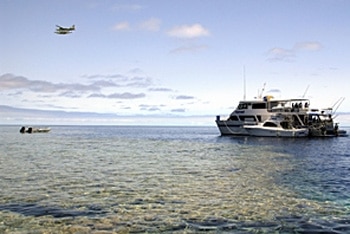
When Capt. George Bransford caught the first 1,000-pound black marlin off the coast of Australia in 1966, little did he know that his catch would open up one of the greatest big-game fishing destinations in the world. Today, a trip to the Great Barrier Reef represents our sport’s World Series and Super Bowl all rolled into one. This is the place where you pull out the big guns – unlimited tackle, rods as thick as baseball bats and 70 pounds of drag.
Combine the good chance of seeing or catching a fish in the 1,000-pound class with the area’s pristine splendor and you get the cliché “trip of a lifetime” – only this time it’s for real. A mothership stay on the Reef can’t be topped for the coolness factor alone. For a good way to enjoy a trip to the Reef without breaking the bank, contact Marlin Expeditions at www.marlinexpeditions.com.
See 1-25 of the Marlin 100 here


